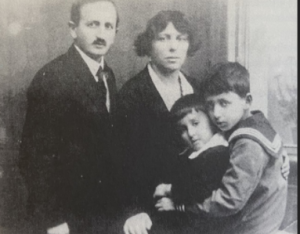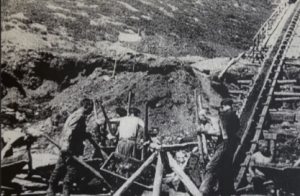Review by Blakely Dishman
Man is Wolf to Man: Surviving the Gulag is a harrowing tale of tragedy and perseverance written by Janusz Bardach and Kathleen Gleeson. The novel is a memoir told from the perspective of Bardach, detailing his journey from young activist to gulag prisoner. He grew up in Poland to a Jewish, middle-class family. The authors used Bardach’s life experience and Gleeson’s background in political science to describe the historical context and details of the period accurately. Without Gleeson’s expertise, the novel would not have had detailed political commentary that advances the reader’s understanding of the historical events. Though the book is not widely known, it is considered “one of the best accounts… of life in the gulag” by Kirkus Reviews (Bardach and Gleeson back-cover). I agree wholeheartedly. Its vivid details and strong theme make the novel impossible to put down.

The title Man is Wolf to Man came, in part, from the Latin phrase homo homini lupus. The proverb refers to situations in which people behave cruelly, as though they were no longer human. The title provides us with the novel’s central theme, and it is fascinating to see it gain relevance throughout the book. After a brief prologue, the memoir begins in September 1939 as Bardach and his family sit at their dinner table discussing the impending World War II. As the novel progresses, the Soviet Union takes control of Wlodzimierz-Wolynski and other parts of Poland. The Bardach family briefly rejoices, “for the first time in several months [his] father was joyful and smiling”, believing that this newfound occupation would bring safety from the Nazis (Bardach and Gleeson 25). Unfortunately, Bardach is quickly conscripted into the Soviet Army, where he is falsely convicted of committing high treason as a military officer. The reader then joins Janusz as he strives to complete his 10 year sentence with his humanity intact. After four and a half awful years of constant violence and fear, Bardach’s brother, a senior officer in the Polish army, manages to get Bardach released from his sentence. Upon arriving home, Bardach discovers that his wife, sister, and parents all perished in the Holocaust. He realizes that “the things that had kept [him] alive” no longer existed, forcing him to find a new source of hope (Bardach and Gleeson 381). In the epilogue, the reader learns about his successful career in plastic and reconstructive surgery. It is up to the audience to decide if helping people through medicine became Bardach’s new source of salvation. With the conclusion of the story, the reader has the opportunity to reflect upon the various instances in which man was wolf to man.
Bardach’s story is deeply unsettling to the reader, and the authors quickly introduce the overall theme. Set in 1941 on the Belarussian front line, the prologue is a jarring introduction to the major message of the memoir. In this section, a Soviet official forces Bardach to dig his own grave. I consider this to be one of the most impactful prologues that I have read because it provides the reader with a glimpse of what is to come for Bardach and solidifies the overarching theme from the start. The first line of the prologue, “the pit I was ordered to dig had the precise dimensions of a coffin. The Soviet officer had carefully designed it,” is a shocking way to open the novel (Bardach and Gleeson 2). From the first page, we know that our main character has many trials to come. After three soul-crushing pages of brutality, the reader feels transported to Bardach’s dinner table in 1939. This transition from hopelessness to familial love is powerful because it helps solidify Bardach’s humanity. It is natural to depersonalize these graphic accounts because it is much easier to believe that this could not happen to a regular, everyday person. This introduction to Bardach in the prologue and first chapter forces the reader to acknowledge the horrors to come and sense the immensity of human loss. The power of the transition shows us the degree to which man is wolf to man. Further, the prologue helps display Bardach’s personality and values. While digging his grave, he states, “I didn’t feel sorry for myself, only sorry that my loved ones would never find my grave,” showing the kindness of his spirit that persevered through many tragedies (Bardach and Gleeson 2). That line serves to humanize Bardach further and remind the reader of the life he once had, strengthening the idea that man is wolf to man.
The second scene that I would like to focus on is emblematic of the concept that man is wolf to man. When Bardach arrives in the gulag in Burepolom, the prisoners are offered the chance to bathe for the first time in months. Upon entering the group shower, Bardach’s excitement over the opportunity is quelled. As he walks through the large room, he sees prisoners beating and raping one another. At this moment, he realizes that there is no “us versus them,” in terms of prisoners versus Soviet officials. Bardach recognizes that a person’s penchant for cruelty is a more potent driving force than the “sides” that he had constructed in his head. He begins to understand that horrible situations can cause people to lose their humanity and treat others animalistically. As he silently reflects on what is occurring around him, he thinks “человек человеку волк – man is wolf to man. My mother taught me this phrase when I was a child. Now it bore into my heart every day, every hour” (Bardach and Gleeson 126). It is at this point that the origin of the title is fully revealed. When thinking of the novel, this scene continuously comes to mind because it features the crucial moment where Bardach’s worldview is broken and shows the exact origin of the title.

In Man is Wolf to Man: Surviving the Gulag, Bardach and Gleeson combine their knowledge to vividly display the absolute cruelty thrust upon the gulag prisoners. The novel is structured elegantly, as it allows the reader to see the life that Bardach once lived and then transitions to the horrors that he endured. By creating the bond between the audience and Bardach, the authors strikingly represented the inhumanity of what happened to Bardach and other prisoners. This novel is a powerful resource for anyone interested in mass human rights abuses or Russian history. While reading Man is Wolf to Man: Surviving the Gulag, it truly feels as though the reader is experiencing the events alongside Bardach. It is an excellent way to further a scholar’s understanding of the horrors that have occurred in Siberia. As they communicate a message about the levels of cruelty that people can achieve, Bardach and Gleeson provide the audience with a gruesome description of this historic tragedy.
Works Cited
Bardach, Janusz, and Kathleen Gleeson. Man Is Wolf to Man: Surviving the Gulag. First, University of California Press, 1998. xi+392 pp.